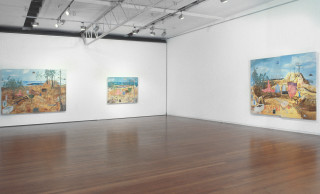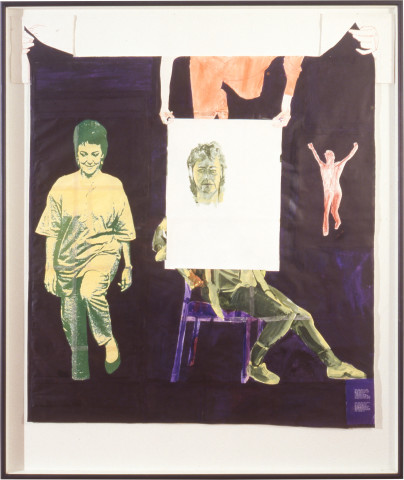Exhibition Dates: 24 October – 3 November 1990
Irene - subject
Geoff - painter
Ian - amateur artist
Arthur - photocopy technician
Peter - framer
Jacqui - photographer
Kevin - social psychologist
There are seven people, I one of them, who bring this work of art to you. Irene lived a life that became the subject of the painting. Geoff responded to his feelings towards the figure of Irene and constructed the images in the painting. Ian listened to what Geoff was thinking about Irene and made his own drawing of her. Arthur took the newspaper images of Irene and made photocopies of them. Peter put all of this into a picture frame. Jacqui set up and executed the photographs of the seven people. Kevin listened to each of their stories and put them into this piece of writing for you.
It was a year before Irene responded to Geoff's invitation to sit for him. She had been 'tied up in the courts' during that year, and decided that while she was unemployed it would be interesting to sit for a portrait. Irene said she didn't have any particular expectations of what the portrait would be like, though she made a point.that she didn't want to be seen as an 'idealised version of anything .. ! wanted truth. "People thought I was some kind of dragon. I wanted it to be as I was really like.'
There were several stages for Irene in the course of sitting for the portrait. She described hers~lf as not 'feeling on top of things' when she first started. 'I was pretty tired and fed up'. Irene sees this particularly in the first portraits. Later, she thought, 'I was more on top of things'. Partly this was due to the realisation that 'this has got to get better ... I can't go on like this'.
lrene's sitting usually started at 10am. Sitting was an involving activity: 'If Geoff was feeling off that day, and you start feeling a bit anxious - how can you do something about it. But I got used to that, all part of the process.' Irene in general prefers the French Impressionists like Monet, as well as van Gogh, but admits that she doesn't know enough about it.
She thought that the photo Geoff had chosen of her was one of her favourites. It was taken on the day of the Industrial Relations Commission. The media were everywhere. Outside television cameramen were lying down in the corridor. 'As I came back, I had to step over them, and there was a particularly nice blonde fellow, and I was stepping over his leg and looking down and someone took a photo of it [laugh] The interesting thing was that I knew what I was thinking, and if people knew what that was all about...'
Irene was at first worried about the 'bit up the top'. She wondered whatGeoff was on about, whether he was 'holding some sort of mask'. She felt more comfortable with it now.
Geoff had thought of asking Irene to sit for him during the nurse's strike. He had just had his first child and despite the disruption of the birth due to the strike, he still thought it was a just fight. Having a child had made him aware that people involved in child care were poorly rewarded: 'The worst paid job is the most important'. The standard rate was $1.79 an hour, which was 'incredibly low paid' compared to real estate agents. It was curious how Irene was on the front page of the papers for almost a year and then suddenly disappeared. This was the first time Geoff had ever wanted to paint·a 'famous' person.
Before the sittings, Geoff looked through all the newspaper reports about Irene. Male journalists seemed to see her as 'sexy': 'Everyone believed in her'. Geoff was interested in 'drawing a person in the room while she was talking, to see how experience exists outside a media representation'.
Geoff was surprised that Irene had almost no self-consciousness about how she looked. She had 'no feeling of invasion'. They talked a lot during the sittings. Irene told a fairly dramatic story of having the full support of the nurses up until their success, when she was dumped. Irene sat for Geoff two days a week for a few months, during which he made over a hundred drawings. Geoff found it easy to paint a likeness of her because of the media image. Drawing Irene, for Geoff, was a 'way of talking' with her and contacting his feelings about Irene.
There were difficult moments. During one period, Geoff found it very hard to find the right pose for Irene. Then one day she came in and sat heavily on the chair. He added the head on the painting from that incident. Geoff saw her as 'angry with a powerful 'mind'.
The colour of her eyes was also a difficult feature of the portrait. Most people seem to remember the colour of the eyes before anything else .. However, blue 'looked stupid' on the canvas. Geoff tried green, then brown, and then heard something like a voice which suggested doing the whole head in 'blue anq yellow'. It was partly the trust in this kind of intuition which Geoff saw as a result of being with Irene: 'Her presence gave me confidence to truth my instincts, not afraid of defiling the image'.
Geoff decided to re-colour the newspaper image in green and yellow partly because he saw Irene as 'intensely Australian ... She came across as a powerful, but not archetypal person: she wasn't an amazon or earth mother. Geoff sees the figure on top looking down as himself, though the person looking at the portrait looks down on the figure in turn. It 'adds a physical aspect'. He decided to make the second figure a woman because it seemed more 'resonant to the painting'. Irene also thought it needed a physical presence. Geoff said that in painting Irene he wanted to work between the media image and his feelings towards her. The amateur artist, Ian, provided the point of view beyond the experience of her presence.
All that Ian had to go on in drawing Irene was his memory of her image from photographs and Geoff's impressions of what he felt about her. At first Ian didn't think I was serious asking him questions about doing the painting: 'I've never been interviewed before, for anything'. Ian said that he was naturally 'intimidated by putting a mark on real painting'. However, he felt that he trusted Geoff enough to overcome this. After warming up, Ian found it very enjoyable: 'I got a glimpse of what it means to be an artist or a painter. I found it really exhilarating -- freedom in expressing your own inner self'. He thought the image of Irene lifting her leg was 'an Irene that I didn't really know'. Ian was surprised that Geoff saw her as so beleaguered, whereas he saw her as 'triumphant'. For Ian, making a work of art involves going outside of what looks proper, and finding an image that fits. He saw it as like not worrying whether the chair was a Chippendale, but whether it worked as a chair.
Arthur works at 'Pro Colour Copy Smith Street'. He is qualified to' fix copy machines as well as make the copies. Arthur finds that his service is being used by artists more and more. The machine Geoff used only does A3 size copies, though it can be programmed to be larger by splitting up the image. There was some difficulty with using rice paper because the roller had difficulty picking it up. He gets some artists coming in to do body photocopying, and finds parts of himself by mistake in the images: 'Every now and then you get a watch or a jumper on the photocopy'. He like lrene's portrait because 'it's got everything in it: ·painting, drawing, photocopying'.
Peter found framing the Irene portrait 'nothing unusual for me': 'I'm a picture framer, if you ask me about the picture frame I could tell you something about that. I try and avoid being involved in the art as a framer. I see so many pieces of art, I have to be objective about what I'm framing. If I was to have an ·emotional involvement with every art work I frame, I'd never get anything done. As soon as I stop the process and look at the picture, I'm losing money.' Peter generally likes photographers like Max Dupain, as well as 'ordinary old wildlife artists'. Peter prefers photography because it is more practical. 'I came to be a picture framer because of a practical leaning towards creativity.'
Jacqui generally likes to take portraits of people which look 'serious and intelligent'. She wouldn't choose a 'laughing face' because 'after a while the-laugh wears thin'. Jacqui mostly sets people up in front of the camera: 'most of my work is very front on'. 'Maybe it's a bit voyeuristic, you can look back at them'. Looking over the proofs, Jacqui liked the direct eye contact. She found this 'more confronting': 'It's interesting to look at someone looking back. It's more related to composition, especially of women'. Jacqui saw the media image of Irene 'An image of happier days, when she used to be freer, not so well known, in terms of her activities.'
As a social psychologist I was interested in looking at the common language people with widely different practices were able to find in contributing to a work of art. One of the themes that seemed to stand out in all the different dimensions was 'being on top of things'. For Irene, it was the display of haughtiness when the photograph was taken of her lifting her leg, as well as the improved spirits during the course of the sittings. For Geoff, this seemed to occur when choosing the colour of lrene's head -- in feeling her confidence enable him to take a risk. For Ian, the idea of making the initial mark on a professional painting was 'exhilarating'. Arthur found his particular mark in the unintended bits of his body left on the 4 machine while it was copying. Peter seemed to take his power from the practical competence of his job. And Jacqui enjoyed the chance to look back on images of other people whose portraits she'd taken.
The portraits themselves also seemed to show themselves 'on top of things'. The witness figure above the main portraits holds the structure in place. Everybody here seemed to have a way of 'doing things' which placed them in control of the action. It is perhaps a fleeting glimpse of group democracy behind the side show of media politics.
 Group Show, A constructed world (in collaboration with John Wolseley)
Group Show, A constructed world (in collaboration with John Wolseley)
Roslyn Oxley9 Gallery, 1997
 Group Show, Stockroom
Group Show, Stockroom
Roslyn Oxley9 Gallery, 1995
 Geoff Lowe Ten famous feelings for men and Tower Hill
Geoff Lowe Ten famous feelings for men and Tower Hill
Roslyn Oxley9 Gallery, 1995
 Geoff Lowe Vietnam paintings
Geoff Lowe Vietnam paintings
Roslyn Oxley9 Gallery, 1994
 Geoff Lowe Geoff Lowe with Rosebud
Geoff Lowe Geoff Lowe with Rosebud
Roslyn Oxley9 Gallery, 1992
 Geoff Lowe
Geoff Lowe
Roslyn Oxley9 Gallery, 1990
 Geoff Lowe
Geoff Lowe
Roslyn Oxley9 Gallery, 1989
 Geoff Lowe What Binds Things Together
Geoff Lowe What Binds Things Together
Roslyn Oxley9 Gallery, 1988
 Geoff Lowe The Idea of Good and Bad Government
Geoff Lowe The Idea of Good and Bad Government
Roslyn Oxley9 Gallery, 1983













